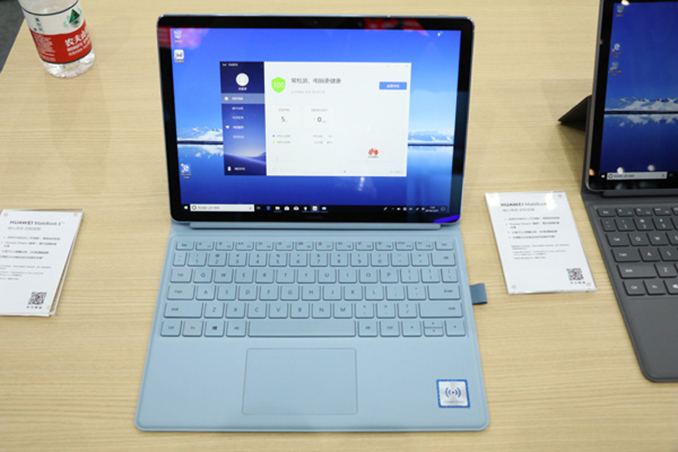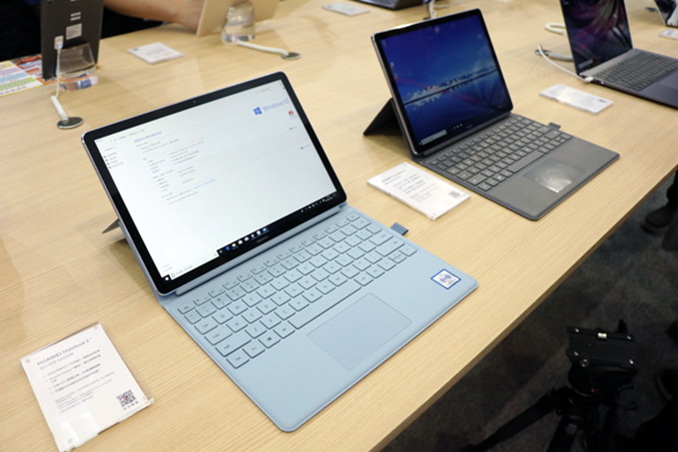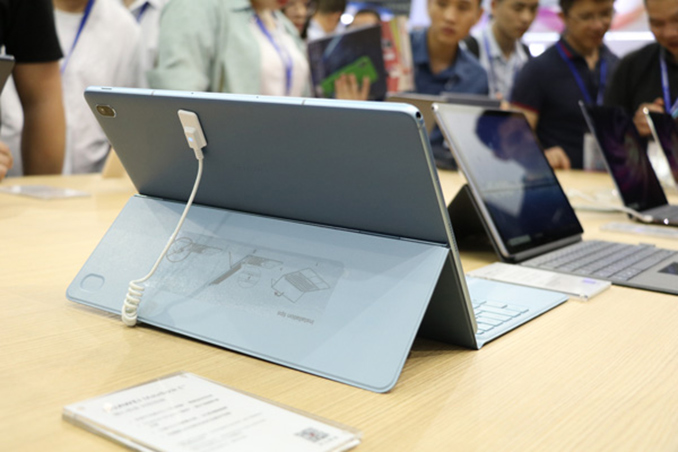Huawei Readies Windows 10 Laptop Based on Qualcomm Snapdragon 850
by Anton Shilov on April 11, 2019 4:00 PM EST- Posted in
- Laptops
- Qualcomm
- Huawei
- Notebooks
- 2-in-1
- Matebook E
- Snapdragon 850

Being a relatively new maker of laptops, Huawei is trying to address high-end and niche markets to gain share, avoid direct competition with numerous rivals at the same time, and preserve its profit margins. With numerous ultra-portable Intel Core-based notebooks in its arsenal, Huawei is working on a Windows 10 on Snapdragon 2-in-1 PC for those who want an always-connected machine.
The Huawei Matebook E 2019 is actually even more portable than the company’s existing offerings. The convertible 2-in-1 notebook comes equipped with a 12-inch display featuring a 2160×1440 resolution, 400 nits brightness, and a 3:2 aspect ratio. The chassis of the tablet (as well as its kickstand) is made of an unknown metal alloy and is 8.5 mm thick, which is a tad thicker when compared to other offerings in this segment. Meanwhile, the tablet itself weighs 690 grams without its keyboard cover and about a kilogram with it, bringing the weight of the whole system to the level comparable with ultra-light notebooks. Speaking of keyboard, it has a relatively large touchpad and an NFC chip to enable Huawei’s Share OneHop service, but no backlighting. Besides, it can hold Huawei’s M-Pen stylus.
The Matebook E is based on the Qualcomm Snapdragon 850 SoC (four Kryo 385 cores at 2.96 GHz, four Kryo 385 cores at 1.7 GHz, Adreno 630 GPU) which is accompanied by 4 or 8 GB of LPDDR4X memory as well as 128 or 256 GB of USF NAND flash storage (it is unclear whether it is expandable using a microSD card). Since we are dealing with a machine powered by a platform originally designed with mobility and connectivity in mind, the Matebook E supports everything you come to expect from an Always Connected PC (ACPC), including the X20 LTE modem (Cat 18, 5CA, 4x4 MIMO, up to 1.2 Gbps DL, up to 150 Mbps U, 802.11ac Wi-Fi, and Bluetooth 4.1. Interestingly, the Matebook E is outfitted with an eSIM, but also has a slot for a regular nano SIM card.
The tablet also has a USB Type-C connector, a fingerprint reader, two stereo speakers, and a 3.5-mm TRRS audio jack. Obviously for a 2-in-1 form-factor, the Matebook E feature the same set of sensors as regular tablets, including an accelerometer, a gyro, a light sensor, and so on. As for battery, it has a built-in 36.3 Wh battery that can last up to 20 hours.
When it comes to imaging, the 2-in-1 notebook has a 20 MP main cam with autofocus and a LED flash, as well as a 5 MP camera for selfies.
Huawei plans to launch its Matebook E 2-in-1 convertible in China already next month, but it is unclear when and if the company intends to release it on other markets as well.
| Specifications of Huawei's Windows on Arm 2-in-1 | ||
| Matebook E 2019 | ||
| Display | 12-inch, 2160×1440 216 PPI |
|
| CPU | Qualcomm Snapdragon 850 4 x Kryo 385 at 2.96 GHz 4 x Kryo 385 at 1.7 GHz |
|
| Graphics | Adreno 630 GB | |
| RAM | 4 or 8 GB LPDDR4X | |
| Storage | 128 or 256 GB UFS | |
| Wi-Fi | 802.11ac Wi-Fi | |
| Bluetooth | 4.1 | |
| WWAN | Qualcomm X20 Gigabit LTE Cat 18, 5CA, 4x4 MIMO, up to 1.2 Gbps DL, up to 150 Mbps UL |
|
| USB | 3.0 | 1 × Type-C |
| Cameras | Front | 5 MP |
| Rear | 20 MP | |
| Other I/O | Microphone, stereo speakers, audio jack, trackpad, etc. | |
| Battery | 36.3 Wh | |
| Battery Life | 20 hours | |
| Dimensions | Width | ? |
| Height | ? | |
| Thickness | 8.5 mm | |
| Weight | Tablet | 690 grams |
| Tablet+KB | ~1000 grams | |
| Price | ? | |
Why Snapdragon and not Kirin?
Ian: When we were at Mobile World Congress, I put it to HiSilicon if they were planning to build a chip for Windows based notebooks with the name Kirin. They said that they were not, for the simple reason that the market is not yet mature. They are more than happy to let other chip manufacturers build a market first, before they insert their own hardware, and would potentially join a mature market, but not at this time. Despite this, this new product shows that Huawei is willing to at least dip its toe into the water with the already verified solutions on the market, even if it isn't Huawei's own chips just yet.
Related Reading
- Samsung Unveils Galaxy Book2: 12-Inch, Snapdragon 850 with X20 LTE, 20 Hrs
- Lenovo Announces Yoga C630: The First Windows on Snapdragon 850
- Qualcomm Announces Snapdragon 850: A Second Generation For Windows
- Lenovo’s Miix 630 Snapdragon 835-Based 2-in-1 Now Available
- HP’s Snapdragon 835-Based Envy X2 2-in-1 Available for Pre-Order, Starts at $999
- Lenovo Unveils Miix 630 2-in-1: Windows 10 S, Snapdragon 835, Gigabit LTE, 20 Hrs
- ASUS Announces the NovaGo (TP370): A Snapdragon 835 based Windows 10 PC
Source: NotebookItalia.it (via Liliputing)













39 Comments
View All Comments
beginner99 - Friday, April 12, 2019 - link
Came here to say this. Why would you want this device? It loses the advantages windows x86 while gaining nothing. Would make more sense to use Linux.Diogene7 - Friday, April 12, 2019 - link
@beginner99It is actually quite the opposite : a ARM based computer with a Qualcomm Snapdragon 8cx (or future, more powerfull version of it) would have the advantages of using full Microsoft Windows 10 system compiled for ARM64 architecture, AND also allow to re-use x86 applications developped for Windows.
Sure the x86 applications will need to use an emulation layer, but if the Qualcomm processor AND Windows emulation layer are optimized enough for this, then the end user experience could be good enough when using those applications.
In My Opinion (IMO), it is a much better way for Windows computers to handle the transition from a x86 processor to ARM64 processor, giving some time to the developper to catch-up and develop applications also optimized for ARM64 processor...
The only thing is that, from my point of view, this makes sense if ARM processors are used in stay fanless and less heat dissipation computers compare to Intel processors, where as of 2019, Intel processors still doesn’t correctly perform
piroroadkill - Friday, April 12, 2019 - link
Yeah. Forced to use Windows 10 forever, without access to any normal programmes, thereby removing the main reason people use Windows. It sounds like a hellish pile of junk.Raqia - Thursday, April 11, 2019 - link
>Why not Kirin?Huawei doesn't have experience working with other OEMs and platforms, and it would take quite a bit of new work for Huawei to write bootloaders, as well as schedulers and drivers that both performed well and in an energy efficient way with Windows. Qualcomm by comparison has had several generations of experience working with various configurations including Windows as evidenced by their bootloader:
https://worthdoingbadly.com/qcomxbl/
Raqia - Thursday, April 11, 2019 - link
P.S. Samsung came to the same conclusion:https://www.anandtech.com/show/13498/samsung-unvei...
Irata - Friday, April 12, 2019 - link
Huawei did a very good job with their Ryzen powered Matebook, something large OEM appear to have a problem with.While this particular model is most likely not for me, I am actually quite confident they will get it right.
tipoo - Thursday, April 11, 2019 - link
Price is going to be king here. If ARM machines are going to be every bit as expensive as x86 then I don't see many people switching, even if the battery life is better. Has to provide a great value proposition in comparison, like Chromebooks used to without the Windows licencing fees.stephenbrooks - Thursday, April 11, 2019 - link
The Samsung version is $1000, seems high, especially when I think of these things as competing in the same space as a $400 netbook. Perhaps I'm underestimating the performance.Irata - Friday, April 12, 2019 - link
Going by the specs, you should rather compare it to a Surface Go which starts at $399 (not including the type cover) and comes with a rather anemic CPU and no LTE connectivity.If you want that, you are already at $679 and still have a worse screen and no type cover.
HStewart - Friday, April 12, 2019 - link
I would think Chromebook would make a better platform for these chips - don't have to worry about x86 compatible.